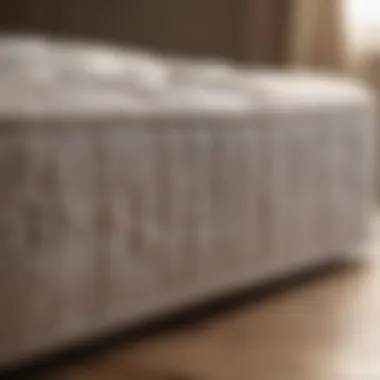Enhancing Sleep Quality on Hard Mattresses


Intro
Many individuals face the difficulties of sleeping on a hard mattress. While firmness can support certain preferences and postural needs, it can also lead to discomfort and disturbed sleep patterns. Understanding how mattress construction affects sleep quality is crucial. Hard mattresses may not conform well to the body, leading to pressure points. This can cause pain and discomfort, particularly in the hips, shoulders, and back. Thus, it is essential to explore potential solutions that can improve the sleep experience for those who find themselves dealing with hard mattresses.
Potential remedies vary from simple adjustments in sleeping position to utilizing additional layers of support. Furthermore, personal health considerations, such as chronic pain conditions or body weight, significantly affect how a hard mattress is perceived. Customizing sleep environments based on these factors might greatly enhance sleep quality.
In this article, we will delve into these challenges associated with sleeping on hard mattresses. We will explore the construction of various mattress types, how they relate to individual health needs, and alternative support systems that can help mitigate the impacts of firmness. Our goal is to offer actionable insights backed by research, ensuring readers can make informed choices about their sleep hygiene and overall well-being.
Understanding Mattress Construction
The construction of a mattress plays a vital role in determining its firmness and support. Mattresses typically consist of several materials, each contributing to the overall feel.
- Innerspring Mattresses: These have a core of coiled springs. The number of coils can affect firmness. More coils often mean better support, but the mattress can still feel hard if the padding is insufficient.
- Memory Foam Mattresses: While these can offer a softer feel, variations in density and thickness can lead to hard experiences. Higher density foam generally provides more support but may feel stiff initially.
- Latex Mattresses: Often firmer than foam, they can offer a unique kind of bounce. People who prefer sleep with a bit of buoyancy may actually find comfort in these options despite their firmness.
Personal Health Considerations
Each person's health circumstances can drastically alter their sleep experience. Common factors include:
- Chronic Pain Conditions: Individuals with fibromyalgia or arthritis may find a harder mattress exacerbates pain.
- Body Weight: Those with higher body weight might sink less into the mattress, making hard mattresses feel particularly unforgiving.
- Preferred Sleeping Positions: Side sleepers may require more cushioning at pressure points compared to back or stomach sleepers.
Understanding these factors can guide individuals in selecting or modifying their sleeping arrangements to enhance comfort.
Alternative Support Systems
There are various solutions to counterbalance the rigidity of a hard mattress. Some of these alternatives include:
- Topper Pads: Adding a soft foam or latex topper can significantly change the feel of a mattress. These pads come in various thicknesses and materials, allowing customization.
- Adjustable Bases: An adjustable bed frame allows customization of sleeping angles. Elevating the legs may relieve pressure on the back, enhancing comfort.
- Proper Pillows: The right pillow can make a substantial difference in how the spine is aligned, reducing discomfort even on a harder surface.
"A good mattress doesn't only provide sleep; it supports overall well-being."
Finale
Addressing the challenges posed by hard mattresses is essential for improved sleep quality. By understanding mattress construction, taking personal health into account, and exploring alternative support systems, individuals can greatly enhance their sleep experience. This journey toward better sleep hygiene is fundamental for overall wellness.
Understanding Mattress Firmness
The concept of mattress firmness is crucial for ensuring quality sleep. It refers to how hard or soft a mattress feels when you lie down on it. Understanding this aspect allows consumers to make informed choices, improving their sleep environment significantly. Firmness can affect sleep posture, pain relief, and overall comfort. If a mattress is too hard, it may lead to discomfort and sleep disturbances.
Definition of Hard Mattresses
A hard mattress is characterized by its firm surface that provides little to no sink when pressure is applied. Typically, these mattresses are made with denser materials that support the body rather than conform around it. The definition is not just about feel; it also includes how the mattress interacts with the sleeper's body.
Factors Influencing Mattress Firmness
Materials Used
The materials used in mattress construction play a significant role in determining firmness. Common materials include innerspring coils, latex, and memory foam. Innerspring coils tend to offer a firmer feel due to their strong support structure. Latex is praised for its durability and consistent support, while memory foam provides a balance between softness and pressure relief, adapting to the body shape. Each material has its own merits and demerits. A latex mattress, for instance, can be a great choice for those seeking durability but may feel too firm for some.
Manufacturing Techniques
Manufacturing techniques also contribute to the firmness of a mattress. Processes such as layering materials and adjusting coil gauge affect the end result. Hybrid mattresses blend different materials for a tailored experience, often combining the support of innerspring with the comfort of foam. This technique allows manufacturers to create varying firmness levels. However, not all techniques yield the same results; some may lead to uneven comfort levels across the mattress surface.
Personal Preferences
Personal preferences greatly influence how we perceive mattress firmness. What feels firm to one person might feel comfortable to another. Factors such as body weight, age, and sleeping positions all play a part. For example, side sleepers may prefer a softer surface to reduce pressure on shoulders and hips, while back sleepers might find firmer options more supportive. Recognizing these preferences is vital when selecting a mattress to meet individual needs.
Measuring Mattress Firmness
Firmness Scale
The firmness scale is a common method used to gauge mattress hardness. It ranges from soft to extra firm, usually graded on a scale from 1 to 10. A level 1 is very soft, while a level 10 indicates extreme firmness. This scale helps consumers identify mattresses that might suit their sleeping style. However, subjective perception can vary, making the scale only a guideline rather than a definitive measure.
Testing Methods
Several testing methods are available to objectively measure mattress firmness. These include pressure mapping and weight distribution tests. Pressure mapping can visually represent how a mattress distributes body weight, helping potential buyers see where support is provided. However, the effectiveness of these methods depends on the brand and their testing standards. Some manufacturers provide detailed data to help consumers understand their options better.
Understanding mattress firmness is not just about personal comfort; it directly impacts sleep quality and health.


Implications of Sleeping on a Hard Mattress
Understanding the implications of sleeping on a hard mattress is crucial for discerning individuals concerned about sleep quality and overall health. Many people do not realize that the firmness of a mattress can significantly affect their sleeping patterns and physical well-being. A hard mattress may seem like a reasonable choice for some, yet it can lead to specific challenges, particularly in how well one can truly rest at night. This section highlights the multifaceted effects a hard mattress can have on sleep quality and health considerations, encouraging a more informed approach to mattress selection.
Effects on Sleep Quality
Sleep Disruptions
Sleep disruptions are a common consequence of resting on a hard mattress. When the surface does not conform to the body's natural curves, it can lead to frequent awakenings and difficulty in maintaining sleep cycles. This aspect of sleep disruptions is particularly concerning as it affects the ability to achieve restful sleep. The key characteristics here include reduced ability to remain in deep sleep stages, which can detrimentally impact overall restfulness. While some may believe a firm surface promotes better spinal alignment, it is equally essential to recognize the individual needs of each sleeper. The disadvantages can become apparent through excessive tossing and turning during the night, which compromises any potential benefits gained from firmness.
Impact on REM Sleep
The impact on REM sleep is another significant factor to consider. Rapid Eye Movement (REM) sleep is the phase associated with vivid dreaming and crucial memory consolidation. Studies suggest that sleeping on a hard mattress can interfere with entering or maintaining this vital stage. The unique feature here is its direct influence on cognitive functions, which are heavily reliant on quality REM sleep. If one does not experience adequate REM sleep, it can lead to cognitive impairments and mood disturbances. Recognizing this link underscores the importance of choosing a mattress that aligns with personal sleep requirements, as each individual may respond very differently to firmness levels.
Health Considerations
Back Pain
A prevalent health consideration when discussing mattress firmness is back pain. Firm mattresses can sometimes exacerbate discomfort for people with existing musculoskeletal issues. The key characteristic here is the pressure points created by a too-rigid surface, which does not distribute weight evenly. Relying on a hard mattress can lead to increased tension in the back, eventually resulting in chronic pain. It is vital that individuals assess their body type and sleeping position to choose a mattress that provides necessary support without sacrificing comfort.
Joint Discomfort
Joint discomfort often stems from a hard sleeping surface that does not adapt to the body's weight distribution. Many individuals experiencing conditions like arthritis report heightened discomfort when sleeping on a firm mattress, as it lacks the necessary cushioning. This choice relates directly to the sleep experience, given that pain can cause frequent wake-ups and hinder restful sleep. Including sufficient padding through additional layers or opting for a softer mattress can alleviate these issues significantly.
Circulation Issues
Circulation issues can arise as a result of prolonged pressure on certain parts of the body, often caused by sleeping on a hard surface. The unique feature here is that a firm mattress can lead to numbness or tingling sensations, limiting blood flow. Individuals with pre-existing conditions such as diabetes or neuropathy may experience exacerbated symptoms due to inadequate circulation during sleep. Addressing this concern often involves selecting a mattress that provides better pressure relief to enhance circulation and overall health.
"Choosing the right mattress is about more than just comfort; it's intrinsic to our sleep quality and health outcomes."
Ultimately, understanding these implications helps individuals make informed choices about their sleeping arrangements. It encourages a holistic view of sleep hygiene, leading to improved mental and physical health.
Assessing Your Sleep Needs
Assessing sleep needs is critical when dealing with a hard mattress. Understanding your body's requirements can lead to choices that enhance comfort and improve sleep quality. Customizing your sleep environment is not merely about picking a mattress but aligning it with personal needs.
Your Body Type
Weight Distribution
Weight distribution plays a fundamental role in how comfort is perceived on a hard mattress. It refers to how an individual’s weight is spread across different areas when lying down. This specific aspect can influence how much pressure is exerted on various points of the body, particularly the hips and shoulders.
A key characteristic of effective weight distribution is its ability to alleviate pressure points. This becomes beneficial for individuals who experience discomfort due to poor support. A well-distributed weight can contribute to better alignment of the spine.
However, one disadvantage is that heavier individuals might find that a hard mattress does not conform to their body's curves, which can lead to discomfort. Thus, understanding your weight distribution is important for selecting a mattress that provides adequate support.
Body Composition
Body composition also significantly impacts how one experiences sleeping surfaces. This term refers to the proportions of fat and muscle in a person's body. It affects firmness preferences and overall comfort when sleeping.
The key characteristic of body composition is that it varies widely among individuals. For instance, those with higher muscle mass might prefer a firmer surface for better support, while those with more body fat may favor a softer surface for pressure relief.
One unique feature of this aspect is its direct influence on how a hard mattress feels. People with an average body composition might adapt better to a harder surface without discomfort, while others may struggle. This variability underscores the necessity of understanding body composition in relation to sleep needs.
Individual Sleep Preferences
Sleeping Position
Sleeping position is an essential factor for determining comfort. It involves how one positions their body while sleeping. This specific aspect can have many implications for spinal alignment and overall comfort during sleep.
A key characteristic of sleeping position is that it directly affects the pressure placed on various body parts. For example, side sleepers might need softer support under their shoulders and hips to avoid aches, whereas back sleepers often benefit from a firmer mattress that promotes spinal alignment.
One unique feature is how a person's sleeping position can guide their choice of mattress type. A mattress that accommodates individual sleeping styles is paramount for achieving restful sleep. Choosing the right firmness level based on sleeping position is crucial for overall satisfaction.
Temperature Sensitivity
Temperature sensitivity is another relevant factor contributing to sleep needs. This refers to how individuals react to the temperature of their sleeping surface. A hard mattress can retain heat, which might impact comfort levels.
One key characteristic of temperature sensitivity is that some people are more prone to overheating during sleep. For these individuals, the choice of mattress can become critical. A hard mattress that traps heat may lead to disrupted sleep.


A unique feature of this aspect is the range of products available that address temperature sensitivity. Options such as cooling mattress toppers or breathable sheets can mitigate discomfort caused by heat retention. Addressing temperature sensitivity plays a vital role in creating an optimal sleep environment.
"Understanding individual sleep needs, in terms of body type, composition, preferences, and temperature, is essential for making informed mattress choices."
Assessing your sleep needs holistically can guide effective solutions to improve sleep quality.
Solutions for Hard Mattress Issues
The challenges of sleeping on a hard mattress can be significant. Many individuals find that a firm sleeping surface negatively impacts their sleep quality and overall well-being. This section highlights practical solutions for addressing the discomfort associated with hard mattresses. From simple enhancements like mattress toppers to more advanced technology like adjustable bases, there are multiple options available. These solutions not only aim to improve comfort but also address various health considerations such as back pain and circulation issues. The integration of supportive pillows further helps in aligning the spine and optimizing sleep posture, leading to a more restful night.
Topper Options
Memory Foam Toppers
Memory foam toppers are recognized for their adaptive characteristics. They contour to the body shape, providing tailored support. This is particularly helpful for individuals who experience pressure points while sleeping. The key aspect of memory foam is its ability to distribute weight evenly, which enhances comfort on a hard surface. Furthermore, these toppers are often made with temperature-sensitive materials that respond to body heat. This can lead to improved comfort, especially for those who have difficulty falling asleep on rigid beds. However, one challenge could be heat retention, which may not suit everyone.
Latex Toppers
Latex toppers offer another alternative that caters to those seeking both support and responsiveness. The key characteristic of latex is its durability and natural elasticity. This provides a bouncy feel, which can help with repositioning during the night. Moreover, latex toppers are often hypoallergenic, making them suitable for individuals with allergies. A unique feature is their breathability, which promotes better airflow, helping to regulate temperature while sleeping. Nevertheless, they can be heavier and more expensive than other options.
Feather Beds
Feather beds are valued for their luxurious softness. They add a plush layer atop a hard mattress, making it a suitable choice for enhancing comfort. The key feature of a feather bed is its ability to offer a gentle cradle around the body, which may alleviate pressure and allow for a more restful sleep. However, they require regular fluffing to maintain their loft and can flatten over time. Additionally, some individuals may find them less supportive than other options, which could lead to back discomfort.
Adjustable Bases
Benefits of Adjustable Bases
Adjustable bases are becoming increasingly popular for their versatility and practical benefits. These bases allow users to alter the position of their mattress, which can help relieve pressure points and improve circulation. By elevating the head or feet, individuals can find a more comfortable position that can reduce snoring and enhance overall sleep quality. One major advantage is that they can adapt to various sleeping habits, catering to different preferences. However, they may have a higher cost and may require a compatible mattress.
Compatibility with Existing Mattresses
Understanding the compatibility of adjustable bases with existing mattresses is crucial. Many modern mattresses, including those made of memory foam and latex, work well with adjustable bases. This compatibility allows for a seamless transition to a more tailored sleep experience without the immediate need for a new mattress. However, not all mattresses function effectively on adjustable bases. For example, innerspring mattresses may not flex correctly, leading to potential damage. Hence, one should always check the manufacturer’s specifications before proceeding with any purchase.
Pillow Choice
Supportive Pillows
The choice of a supportive pillow is vital for enhancing comfort with a hard mattress. Supportive pillows help ensure proper alignment of the neck and spine, reducing strain during sleep. A well-designed pillow maintains the natural curvature of the spine and eases pressure on shoulders and hips. The materials can range from memory foam to natural latex, each offering various degrees of support. Despite these advantages, some may find specific types too firm or not adjustable enough for personal preference.
Pillow Loft Considerations
Pillow loft considerations relate to the height and thickness of the pillow. A pillow with the right loft is essential to maintaining proper head and neck alignment. For individuals who sleep on their back, a medium loft pillow is often ideal. In contrast, stomach sleepers typically benefit from a thinner pillow. Higher loft pillows may provide discomfort and lead to neck pain for side sleepers. The importance of selecting the correct loft cannot be overstated, as it significantly affects sleep quality and comfort.
Innovative Approaches to Sleep Comfort
The quest for better sleep involves understanding innovative approaches that can greatly enhance comfort for individuals using hard mattresses. Recognizing how traditional sleeping surfaces affect sleep quality is vital. Innovative solutions bridge the gap between firmness and individual comfort needs. These options can lead to improved sleep hygiene and overall well-being, making them worth exploring for anyone who struggles with hard mattresses.
Customized Mattress Solutions
Made-to-Order Mattresses
Made-to-order mattresses represent a significant step toward personalized sleep experiences. The key characteristic of these mattresses is their ability to be tailored to individual preferences regarding firmness, materials, and size. This customization contributes to the goal of the article, which is to improve the sleeping conditions for those who find their hard mattress unsuitable.
One unique feature of made-to-order mattresses is that they are designed based on detailed customer specifications. The advantage is a mattress that aligns with personal comfort needs, reducing sleep disturbances caused by uninformed choices. However, potential disadvantages can include higher costs and longer waiting times for delivery.
Sleep Trial Options
Sleep trial options allow users to test a mattress for an extended period before making a final commitment. This aspect is crucial as it ensures that individuals have the chance to evaluate comfort and support. The key characteristic of sleep trials is the flexibility they provide; consumers can sleep on the mattress for weeks or even months, ensuring their purchase is the right fit.
The unique advantage of sleep trial options is the ability to return the mattress if it fails to meet expectations. This feature mitigates the risk associated with buying a high-cost product without testing it. However, potential downsides could include restrictions on returns or conditions that need to be met for a successful return, which can sometimes complicate the process.
Technology Integration
Smart Mattresses
Smart mattresses are an embodiment of modern technology integrated into sleep solutions. The defining characteristic of smart mattresses is their ability to adjust firmness levels automatically and provide data on sleep patterns. This flexibility can drastically enhance comfort while addressing the needs of individuals accustomed to firmer surfaces.
A unique feature of smart mattresses is their integration with mobile applications, allowing users to monitor and adjust mattress settings from their phones. The advantage lies in real-time adjustments and insights into sleep quality, which can inform better lifestyle choices. On the flip side, these mattresses can be priced higher than traditional options, which could deter potential buyers.


Sleep Tracking Devices
Sleep tracking devices provide insights into sleep patterns and behaviors. The core aspect of these devices is their capacity to monitor various metrics. Users can gain valuable information about their sleep quality, including hours slept, movements, and even heart rate.
One of the main benefits of sleep tracking devices is their ability to inform users about their sleep habits, allowing for adjustments in lifestyle and sleeping arrangements. However, drawbacks include possible inaccuracies and dependence on technology, which may not appeal to everyone seeking a simpler solution for hard mattress issues.
By integrating innovative approaches and technology in sleep solutions, one can create a more adaptable and supportive sleep environment.
When to Consider a New Mattress
The decision to acquire a new mattress is often critical and requires a careful appraisal of various factors. Understanding when to make this investment can noticeably impact sleep quality and overall health. A person’s mattress should not just support their body; it needs to adapt to changes in lifestyle, health, and comfort preferences. When considering a new mattress, two major categories stand out: signs of wear and tear, and changing sleep needs, both of which indicate significant changes in mattress performance and personal comfort.
Signs of Wear and Tear
Visible Indentations
Visible indentations on a mattress can be a clear indicator that it is time for a replacement. Over time, materials in a mattress can compress unevenly due to pressure from body weight. These indentations may be subtle at first but grow deeper as the mattress ages.
Key characteristic: The level of indentation directly correlates with the loss of spine alignment during sleep. Sleepers may notice that they sink into the mattress unnaturally, which can lead to discomfort.
Advantages: Recognizing these changes early can lead to improved sleep quality. Investing in a new mattress can help alleviate pressure points.
Disadvantages: In some cases, individuals may put off buying a new mattress, ignoring these signs under the rationalization that they still feel comfortable.
Loss of Support
The loss of support is often felt as a gradual decline in mattress performance. As a mattress loses its structure, it can no longer provide the necessary support for the spine and joints. This may lead to discomfort, particularly in individuals who sleep on their back or stomach.
Key characteristic: The feeling of being unsupported can lead to restless nights and poor sleep quality. The natural curvature of the spine needs consistent support to prevent aches.
Advantages: Recognizing a loss of support can prompt timely action to seek a new mattress, potentially reducing or preventing chronic pain issues.
Disadvantages: Many people may continue to use an inadequate mattress. Discomfort may be seen as tolerable but can escalate into something more serious.
Changing Sleep Needs
Life Changes
Life changes — such as moving in with a partner or having children — can significantly alter sleep needs. The requirements for space, comfort, and accessibility may shift. Needs will vary, depending on factors like age, lifestyle changes, or the introduction of different sleep routines.
Key characteristic: Adaptability of the sleep environment is crucial. The same mattress may not suffice when sleeping styles or requirements evolve.
Advantages: Acknowledging life changes can lead to proactive sleeping solutions, ultimately improving overall sleep experience.
Disadvantages: Many people fail to consider that even a well-regarded mattress may not suit their new circumstances, leading to discomfort down the line.
Health Changes
Health changes are another crucial factor to consider when evaluating the need for a new mattress. Conditions such as arthritis, pregnancy, or chronic pain may require specific support levels or materials for comfort. These changes often necessitate reevaluation of existing sleep solutions.
Key characteristic: A mattress that once provided adequate support may no longer cater to an individual’s health needs.
Advantages: Being proactive in adjusting one’s mattress to align with health changes can prevent further complications and improve sleep quality.
Disadvantages: Some may overlook these signals, thereby risking exacerbation of their health issues, impacting their daily function.
It is paramount to remain aware of how changes in one’s life and health impact sleep needs. Recognizing these signs can facilitate a smoother transition to a more suitable sleep solution.
Closure
In the pursuit of sleep quality, understanding the nuances of mattress firmness and the specific effects of hard mattresses is paramount. This article illuminates the complexities surrounding sleep comfort and emphasizes how mattress choices directly impact overall well-being. By synthesizing critical insights from various sections, we see that a hard mattress can present significant challenges to both sleep quality and health.
Summarizing Key Points
The examination of hard mattresses reveals several key takeaways:
- Effects on Sleep Quality: Hard mattresses can lead to sleep disruptions and negatively influence REM sleep, essential for cognitive function and emotional regulation.
- Health Implications: Continuous use of a hard mattress may result in back pain, joint discomfort, and circulation issues, highlighting the importance of tailored sleep solutions.
- Assessing Sleep Needs: Understanding individual body types and sleep preferences is crucial in choosing appropriate mattress firmness. Personal factors like weight distribution and sleeping position should take precedence in decision making.
- Solutions Available: Options such as mattress toppers, adjustable bases, and appropriate pillow choices can greatly enhance comfort. Custom-made solutions or technology-integrated mattresses also show potential for improving sleep environments.
Future Considerations for Sleep Quality
Looking ahead, several factors merit attention for those focused on improving sleep quality:
- Continued Research: The field of sleep science is ever-evolving. Ongoing research into the effects of varying mattress firmness on health can provide deeper insights.
- Changing Lifestyle Needs: As life circumstances, physical health, and preferences shift, individuals may need to reassess their mattress choices. Understanding this dynamic nature will aid in long-term sleep health.
- Technological Advances: The integration of technology into sleep solutions represents a promising frontier. Innovations in smart mattresses and sleep tracking may play an essential role in personalized sleep strategies.
"The room of sleep is a complex space; the choice of mattress shapes the landscape of rest."







